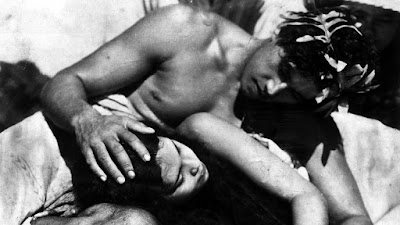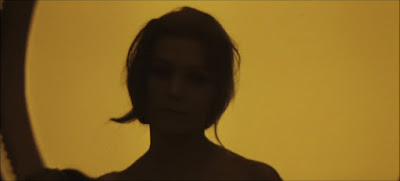Directed by Hou Hsiao-Hsien, Taiwan, 1998
A brief opening title sets the scene: late 19th century Shanghai's opulent Flower Houses, brothels attended by the wealthy. The film fades in on a group of men gossiping and playing rowdy drinking games. Silent, serene women stand around them, occasionally whispering among themselves or strategically contributing to the men's conversation. The camera drifts around the outskirts of the group, capturing the conversation's flow without emphasizing one particular person. It's a naturalistic scene that feels unscripted and unrehearsed - like the camera is a portal into an everyday moment in the past. The shot lasts nearly ten minutes uninterrupted.
It takes an unusually gifted director and cast to make a lengthy, un-showy sequence like that engaging, but Flowers of Shanghai immediately immersed me into its world. Each scene plays out in a similar way - the film fades out of one shot and into another, each a tableaux of life in Shanghai's flower houses that never feel enacted for the sake of an audience, but like discreet glimpses into past lives. This approach to historical recreation is not dramatically satisfying in the conventional sense. Flowers of Shanghai loosely follows several major characters, but they come and go, and major events often occur off-screen. Melodrama of any kind is elided, and despite taking place in a brothel no sex is shown. Like in real life, conversations are rambling and unrushed, and people often do not say what they really mean.
Flowers of Shanghai is more anthropological than dramatic. Through observation we slowly learn how this cloistered world operates. Each flower house is run by a madame who buys girls as young as 7 or 8. She trains them to become specialized courtesans called flower girls once they are teenagers. Flower girls are visited by wealthy patrons, who form relationships (or contracts) that are often semi-monogamous. The patrons support the girls, buying them clothes and jewelry, and the girls provide companionship, a sentimental education, and sex. The luckiest (and smartest) flower girls are bought, at an exorbitant price, out of the houses and into marriage - usually as a second or third wife, as no upper-class gentleman would take a courtesan as his first.
As in all his films, director Hou Hsiao-Hsien studies how individuals are shaped by, and survive within, their environments. We observe that the women who flourish as flower girls are practical businessmen, who know when to be charming and when to be cruel. The women who are incapable of adapting are beaten down ruthlessly. The men are careless and harsh, often without intending to be. Their hierarchal power is so ingrained and unquestioned that they aren't even aware of their cruelty. In this environment, falling in love is dangerous and short-lived, though it still happens. The glimpses of unselfconscious emotion in Flowers of Shanghai - whether tenderness or anger - are startling for their precious authenticity in a society ruled by money, status, and inequality.
Flowers of Shanghai is beautiful and suffocating. Every scene takes place indoors, with cinematography lit only by the light of oil lamps. Everything is lushly beautiful, from the flower girls' dresses to the ornate decor and lavish meals; but it's also overwhelming, a world smothered in things. The slow drift of the camera, droning strings score, and slow fades between scenes gives Flowers of Shanghai a soothing, hypnotic quality, like being lulled into an opium dream (that could just be a secondhand high from all the opium smoked in the movie).
Hou Hsiao-Hsien is unique in his vision as an artist. His films are both practical and poetic, as they rarely escape mundane realities but nevertheless become dreamy, mysterious experiences. Flowers of Shanghai is among his finest films - not as endearing as Cafe Lumiere or as awe-inspiring as The Assassin, but a powerful, vivid recreation of a long-gone world.




















